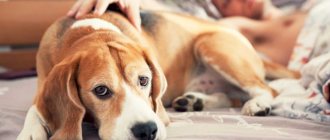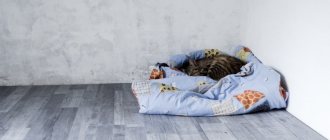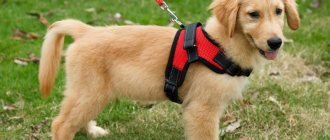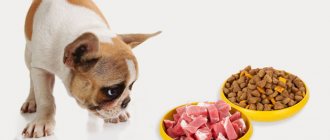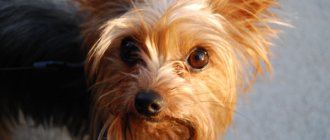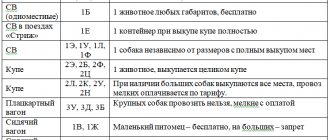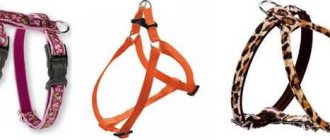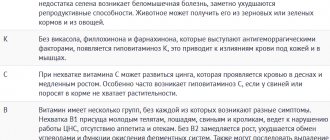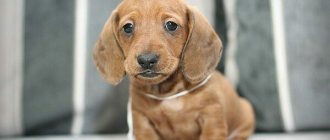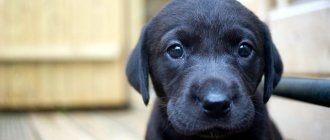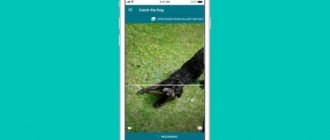The period when the puppy is in the house for the first few days is a lot of stress for both the baby and all family members. Regardless of whether the dog is the first pet, or whether there are other animals in the house, the owner and all household members must make every effort to ensure that the baby’s adaptation is quick and painless.
Today we will tell you what to do when a puppy has just arrived in the house: how to feed your new pet, how to entertain him, and also how to get out of many situations that are sure to happen. For example, what to do if the puppy whines, chews things, constantly asks to be held, or interferes with sleep.
A puppy's first days in the house: what to do?
A puppy's first days in the house - how to care for him?
It is best to bring the puppy home in the morning. During the day he will get used to the new home a little and he will not be so sad the first night without his mother. Before you bring your puppy, you need to prepare your apartment. The most important task is to remove all carpets from the floor. At first, until the puppy gets used to using the toilet outside, he will do his “dirty business” directly on the floor. Agree, it’s easier to clean up after it from a clean floor than to wash the carpet.
If you have carpets at home, take them to the dry cleaner, then wrap them in plastic and hide them somewhere. When the puppy gets used to not peeing on the floor, the carpets can be returned to their place.
At first, help the puppy get acquainted with the apartment. Take the baby in your arms, show him around, then offer him something to eat. Most likely, after eating he will want to sleep a little. Take him to a pre-prepared place and put him to rest.
- During the first days, all puppies sleep a lot and there is no need to disturb them in this. Your children need to be taught that your puppy needs plenty of rest to gain strength. When he gets a little older they can play with him all day long.
- To emotionally relax the puppy, because moving is a big stress for him, you need to put a toy or a piece of fabric with familiar smells next to him. There should be toys left where the puppy lived before that you can take with the puppy.
- If there are no such items, place a piece of rag near the place where he slept, where his mother is. After a few hours, the rag will be sufficiently saturated with native odors. You can spend this time talking with the puppy's owner. Find out how to care for him, what to feed him, how to raise him
- The first days the puppy is very fragile, he needs your affection and care. Never pick up a puppy by grabbing its tummy, as this will compress its internal organs and cause discomfort. It is better to lift with one hand holding the chest, and the other holding the pelvis to the side
In the first days, you must decide whether you will allow the dog on the bed. They love this place very much; it will be very difficult to wean him from climbing onto the bed. Therefore, if you are happy for your dog to walk on the bed when he is an adult, you can take the puppy to bed. Never leave him alone on the bed until he learns to jump on and off it himself. Otherwise, trying to get away, he may fall and damage his paws.
Preparation
Regardless of where you plan to keep an adult dog - in an apartment/house or on the street, you should take a puppy into the house for the first time. There you will get used to each other, learn understanding and good manners. Also, the puppy should be protected from contact with the street until the necessary primary vaccination is completed and the baby’s immunity is strengthened.
Security and Protection
When the puppy first appears, he will begin to explore and taste everything, so remove everything unnecessary from his reach.
Shoes, wires, children's toys - all this can not only be damaged by the puppy, but can also harm his health
Be sure to remove carpets from the floor if you have them - at first the puppy will do his business wherever he has to, before you teach him to do it where he is supposed to.
What does a puppy need in the house?
From the first day of being in a new home, the puppy will need certain conditions and objects for full development, growth and training to comply with established rules.
Own place
Photo: Donika Sadiku A dog, like any animal, needs its own “corner” where it will feel safe.
Immediately determine where the pet will have his place and, if possible, equip it as comfortably as possible. The place should not be located in a passageway, near a door or in a draft. It should be both secluded and have a good view from it (for example, the corner of a room). At a minimum, the puppy should have its own bed (preferably with sides), it is better if it is a cozy house like a kennel with soft bedding. It is important that no one invades the puppy’s territory, so that the pet understands and knows that there is only his place, where he is comfortable and calm.
You can also equip your puppy with a fenced-off space in a place convenient for you, where he can run freely. It will be possible to place his bowls and toilet there.
Bowls for food and drink
The puppy will need separate dishes for food and water. You should choose bowls depending on the breed of your pet (for example, for breeds of medium size and above, you should use a stand for bowls with adjustable height for the correct posture of the dog; for long-eared breeds, specially shaped bowls that prevent long ears from getting inside; for breeds with flat faces Do not use deep dishes, as it will be difficult for them to reach the contents).
Dishes for food and feed should be placed away from the area reserved for the toilet; hygiene rules should be taught immediately.
Feed
A dog needs its own food, prepared especially for it according to a balanced diet. This is especially important during puppyhood. And remember that you cannot feed your pet the same thing that you eat yourself - a number of foods that we eat are contraindicated for dogs.
It is best to feed the new inhabitant of your home the same thing that the previous owners fed him.
If for some reason you find the puppy’s previous diet unacceptable, then you should not switch your dog to a new one immediately, but later and gradually, in order to avoid unnecessary stress and possible intestinal upset.
If you don’t know what the puppy ate before it came to your house, then for feeding you can use boiled chicken and sea fish without bones, low-fat cottage cheese, and other fermented milk products. In the future, you can gradually switch to good quality dry food.
If your puppy is too small and cannot yet eat on his own, then a bitch milk replacer will help you in this case. You can purchase it at a veterinary pharmacy, as well as a bottle for its use.
Toilet space
From the very first day, you will need to strictly determine the place where the puppy can relieve himself. It is better if this place is in a fairly secluded place. There, place a diaper (disposable or a special reusable one that can be washed) or a tray (the main thing is that its sides are not too high for the baby).
Be patient, the puppy will not immediately figure out where he should go to the toilet, and you should not scold him when he does it anywhere. As soon as you notice that the puppy has sat down to relieve itself, immediately transfer it to the tray (on the diaper). When the puppy goes to the toilet in the right place, praise him, let him immediately begin to understand that this is good.
Toys
Photo: Chris Jimenez Toys (balls, rubber bones and rings, special ropes) are very important for a puppy - they help him develop, protect your things from possible gnawing, and are simply a remedy for boredom.
An important requirement for toys is that they be made from safe materials with a dense consistency so that the puppy cannot bite off pieces of them with his sharp teeth. It is also worth choosing a toy for your pet of a suitable size so that he can easily grab it with his teeth and carry it.
It is best for your puppy to purchase special toys designed specifically for dogs; they are sold in pet stores. Never let your puppy play with soft toys, unnecessary shoes or other things that are not intended for this purpose. Otherwise, you can harm your pet's health, and in addition, you will instill in him the bad habit of gnawing on foreign things.
First aid kit
It is best to visit a veterinarian as soon as you have adopted your puppy so that he can assess the general health of the pet and give general advice on care and feeding. He will also give advice on what medications you should have at home and why.
However, in any case, you will need bandages, cotton wool, antiseptics (chlorhexidine, levomekol), as well as drugs used for intestinal disorders and poisoning (smecta, activated carbon, etc.).
In the future you will need
In the first days in a new home, the following items will be superfluous, but as your pet grows you will need them:
- ammunition - a collar and leash or harness will be useful for training and walking your pet
- grooming products - dog shampoos, combs, nail clippers, etc. will be needed to keep your pet neat and aesthetically pleasing.
Even if you received a puppy with dirty fur or parasites, do not rush to bathe him on the first day - this will become additional stress, let the pet get comfortable and get used to you a little.
What will be required of you
Caring for a puppy is not easy, especially if you have just adopted one. He needs a lot of attention and care, so if you are planning to adopt a puppy, then plan to spend time with the puppy for the first time (for example, during a long weekend or vacation) until he gets a little used to being alone.
When a small puppy appears in the house, you should be careful and attentive in your usual actions, so as not to accidentally injure the pet (step on the paws or tail, hit with a closed door, etc.)
Keep in mind that, most likely, the puppy will whine and act restless the first night (and possibly the next few), because he is in a new place and for the first time alone, away from his mother and brothers and sisters.
The puppy is a month old - how to stop a dog from peeing at home?
Remember that for the first month the puppy will pee at home from time to time. The whole point is that at this age a dog cannot endure for long. You need to learn to understand when she wants to go to the toilet. To do this, you need to monitor her habits. At first, you will inevitably be constantly cleaning up after your pet.
- Carpets encourage your puppy to go to the toilet right on them. Perhaps the fleecy surface tells them that this is the best place to relieve themselves. You must remove all carpets from the floors in the house. Next you need to teach the puppy to go to the toilet outside, so you will gradually wean him from doing it in the house
- You can tell your puppy that he is doing something you don’t like only at the moment when he does it. Therefore, if you see that he has sat down and the process has begun, you can lightly slap him on the rump, reinforcing your words with indignation. Don't hit him too hard - you should make it clear that this is not good, and not hurt him or harm him
- When you are walking outside and the puppy starts peeing there, be sure to praise him after that, pet him, or maybe give him a treat. This way he will quickly understand that it is better to cope on the street, but this cannot be done at home. Gradually, your dog should get used to the command “Fu!”, so start saying it when the puppy copes at home
- If you are late, and your pet peed even just five seconds ago, there is no point in punishing him. You shouldn't speak in a stern voice either. He will not understand why he is being scolded. In the first days, you should literally follow the puppy every minute and wait for him to pee or poop. The more you miss the right moment, the more difficult it will be to teach him to do his business on the street, and not at home.
What to feed a puppy for the first days
The owner should decide in advance what to feed the puppy for the first days and purchase the necessary products or ready-made food.
You should not start complementary feeding with dry ready-made food. In the first days, it is better to give preference to ready-made canned food and pates. Some experts allow feeding dry granules soaked in warm water, broth or milk.
Important! The quality of feed should be no lower than super premium class. Optimally, you need to choose holistic people.
If you decide to feed your puppy natural products, you should include in the menu:
- dietary meats;
- porridge made from buckwheat, brown rice or low-glycemic oats;
- dairy products;
- boiled carrots and zucchini;
- fish fat;
- boiled eggs.
Vitamin and mineral complexes selected according to the animal’s age should be added to the diet, but river fish and whole cow’s milk should be avoided.
How to house train a puppy?
Give the puppy time to adapt. Moving to a new home is a big stress for him, which is accompanied by separation from his mother. He needs to explore all the rooms, get used to the smells, only after that he will be able to feel calm in the apartment.
- In the first days after the puppy appears in the house, do not bathe it under any circumstances. Additional emotional shocks will make the adjustment time longer. It is important to surround the puppy with care, talk to him, spend as much time with him as possible. He must feel that he is loved here and welcome in this house
- At the same time, teach the puppy his name. Everyone has their own place in the house, and the dog should have it too. Set aside a place for the puppy and gradually accustom him to the “Place” command. Your dog should always go to his place when you tell him to. He will not learn to do this right away; do not demand great results in the first days. Everything must be gradual
- For the first few days, you can carry the puppy in your arms, walk with him and talk about your home. This way he will get to know him faster and get used to his new place of residence. It is advisable to remove all wires and objects that the puppy could bite or swallow while playing.
We pick up a puppy from the breeder
If you are taking a puppy from a breeder of the breed, then it will be useful for you to find out some details about keeping the pet, and in the future you can always turn to the breeder for advice, because he has experience in raising dogs of this breed.
What you need to know
Ask the breeder about the character traits of your puppy; as a rule, they have time to prove themselves by the age when they are looking for a new home.
Photo: Cole Young It is also important to find out from the previous owner the specifics of the pet’s feeding diet and in the first days of being in the new home you should stick to it.
Information about the puppy’s previous living conditions will be useful; it will make it possible to minimize stress by creating familiar living conditions for him.
It is important to clarify what veterinary procedures were performed on the puppy: deworming, necessary vaccinations, etc.
What to take with your puppy
When picking up a puppy from the breeder, do not forget to take the pet’s veterinary passport, which should indicate the veterinary treatments performed, as well as documents confirming the pedigree (puppy card or birth certificate).
It would not be a bad idea to ask the previous owner of the puppy for some thing or toy that was close to the mother and offspring and absorbed their odors. They will remind the puppy of home and will allow him not to feel lonely; these things will be especially useful on the first night.
How to transport a puppy
Soft carrier It is best to take the puppy home in a soft carrier, but so that his muzzle is outward and he can see everything around him.
If the baby is scared, then hold him close to you, this will calm him down. Keep in mind that on the way he may wet himself or get seasick, so agree with the breeder in advance about the time and ask not to feed the puppy before the trip, and also take water, napkins and bags with you.
How to toilet train a puppy at home?
In order to train a puppy to use the toilet at home, you need to determine the moments when he wants to go to the toilet. Usually puppies go to the toilet immediately after sleep or some time after eating. The puppy does not go into a secluded corner to pee, so you can easily see when he is ready. As soon as he wakes up, immediately pick him up and take him to the litter box.
At first, the pet will not understand what is needed from it and will run away from the tray. You must patiently return it to its place, while repeating the phrase “Toilet.”
When you are with your puppy near his litter box, you should have something very, very tasty. As soon as he goes into the litter box, give him a treat immediately. Several such trainings in a row will tell the pet that the only place to go to the toilet is in the litter tray.
Feed
Food is selected based on the age of the puppy. It can be wet or dry. For babies from 2-3 months of age, premium ready-made dry diets are suitable. Several manufacturers for example: Hiils, Royal Canin, Purina, Brit, Acana, etc. Not all foods are equally healthy. Cheap food is not bad - it just does not contain the vitamins, microelements and minerals that are so necessary for a growing body, and yet they are so important both in the first years of life and thereafter.
Natural food is also a pretty good option, but then consider several aspects:
- it is not the food you eat;
- food from the table is absolutely not suitable for animals, because... contains a large amount of salt, spices, sugar - all this is not absorbed by the body and can lead to serious problems in the health of your pet;
- food for the pet is prepared separately, strictly according to the rations for a particular breed;
- it can spoil, especially when the house is warm and you leave the bowl and go about your business - this can lead to food poisoning.
How to make a puppy's new home with your own hands?
If you live in an apartment, a new house for a puppy can be made from available materials; you don’t have to build a real house for this. For small dogs, you can use an old suitcase. Open it and fix the lid in a static position in any way.
You can sew a ready-made pillow inside or simply make a foam preparation. This material is better because it is able to remember the anatomical features of pets. As a result, he will always be comfortable in such a house.
You can build a real house in the form of a tent. Assemble the frame of a dog house from plastic tubes or any other material. Place an awning on top so that the entrance has a small threshold; dogs love the complete protection of their home.
It is better to make the bottom of such a house in several layers. The bottom one should be made of plastic film to protect the floor covering from surprises. Next is a soft and comfortable pillow. Carefully measure the dimensions of your pet, taking into account the fact that it will grow. Even though dogs can fit in tight spaces, most dogs enjoy spacious homes.
Vaccination
We hope that upon reaching you, the baby will already be dewormed and vaccinated. If this is the case, then the previous owner must give you a veterinary passport with vaccine stickers and marks (stamp and signature of the doctor) of the veterinary clinic! If there is none, then we would not recommend taking your word for it. This is such an important stage on the path to a healthy and happy life for your pet!
The puppy must have its first vaccination at 2 months of age, unless the veterinarian gives other recommendations. Before vaccination, the animal should be dewormed (strictly in accordance with the weight and age of the pet, as well as checking the expiration date of the drug) and after 7-10 days come to the clinic for the first vaccination in its life.
Then the first vaccine is fixed with the second, with rabies. Only after 30 days of the incubation period, after the second vaccination, can you go outside with your baby. Also, do not forget to deworm your baby (drive away worms) every 3 months and treat for fleas and ticks once a month. Even if he doesn't go for walks yet! Your doctor will tell you about your next steps.
Holding a puppy in your arms all the time - won't it harm him?
The puppy must receive a certain dose of activity. Constantly carrying it in your arms is harmful, since the puppy will lag behind in its muscle development. In practice, if the puppy does not walk on his own, but is constantly carried in his arms, you should contact a veterinarian; perhaps the pet already has motor abnormalities.
Excessive sleepiness of your little four-legged friend should not be confused with lack of activity. It only takes a small dog to run around the apartment for a short time before he wants to sleep. Over time, his body will get stronger and he will need more and more walking.
Remember, dogs require a lot of attention. If you bring a puppy at home, consider that you have a child and a full-fledged member of the family. While he is small, you can often carry him in your arms, but gradually teach him to walk on his own. When you carry a puppy in your arms, hold him correctly, never putting pressure on his tummy.
What else needs to be done
When the priority chores are over, it's time to do other mandatory things.
Give the puppy a name
Photo: ChikoBirdyhof Come up with a nickname for the dog, even if the name has already been assigned in the pedigree, you will still most likely need to decide on a more sonorous derivative nickname (or a simpler version of it). Gradually accustom the puppy to its nickname, literally from the first day in your home. Until the puppy understands that the nickname refers to him, the nickname itself should only be pronounced in a calm and soft tone, and after getting used to it, you can make accents with your voice (for example, call him strictly if he is misbehaving).
Visit a veterinary clinic or call a veterinarian at home
It would not hurt for your new pet (and if you adopted a puppy from the street, it is mandatory) to be examined by a veterinarian for a general assessment of its health and development. He will also advise you on the necessary veterinary treatments and their timing, and carry them out if necessary.
If your puppy does not yet have a veterinary passport, then your veterinarian will be able to get it properly issued right away.
Contact the kennel club
If you have a purebred puppy and the breeders have given you his metric (puppy card), then you should contact the kennel club to formalize the pedigree and register with the club for the purpose of further participation in exhibitions.
What to name a boy puppy?
It is advisable to choose a nickname for your pet that will differ from similar human names. On a walk, it will be very inconvenient if your dog and the neighbor’s boy are called by the same name. Some neighbors may even be offended.
Choose a nickname for the boy puppy that will reflect either his appearance or his differences in character. Accordingly, for small dogs you need to choose more gentle nicknames. Large dogs can proudly bear respectable names.
Here are some examples of what you can name a boy puppy:
- Lord
- Tsar
- Theis
- Velvet
- Chapik
- Link
- Drago
What to consider when walking
Recommendations for walking in a new place that must be followed so that the dog does not get lost:
- do not let off the leash at first;
- make sure that the chip contains new information about your place of residence;
- put a medallion with a phone number and address on the dog’s neck.
Even dogs with perfect obedience in a new, unfamiliar area may become confused and not immediately respond. Wait until your pet's stress goes away and new experiences are no longer overly vivid. Only then can you start letting him off the leash.
Make sure your dog relieves himself while walking. To do this, take him out more often in the first 2-3 days. When moving, some dogs tend to get confused about where they can do their business and where they can’t. Let your pet remember the “rules of the game.”
Long, active walks will benefit your dog. During games, endorphins hormones are produced, giving a calming effect.
How to name a puppy girl?
The names of girls' puppies should also not be similar to human names. Keep in mind that pet names and abbreviations should sound like nicknames. Usually nicknames for girls have a feminine ending.
Some names you can use for a girl puppy:
- Vitamin
- Don
- Dasya
- Klyopa
- Nasta
- Pekki
- Palm
- Tilde
- Yagda
The choice of nicknames is very large. Some people like well-known nicknames like Rex, Kashtanka, and so on. Choose a name for your pet that you can pronounce easily and sonorously. Avoid complex names that are difficult to pronounce.
Safety
You may not even think about the fact that your puppy may be in danger at home. Here are some of them:
● Electrical wires.
For the first six months, or even a year, the dog will try everything that doesn’t fit well. Wires are especially dangerous in this regard; the baby can get an electrical injury, so they need to be carefully hidden.
● Slippery floor.
During play, the puppy may slip, injure its paws, or hit walls or furniture painfully. If the flooring is slippery, it is better to lay rugs.
● House plants.
They need to be put away in a place where the puppy cannot reach them. Many plants are toxic to pets.
● Small and fragile items.
Remove children's toys and magazines from the floor. A curious puppy can eat them and get poisoned or have an intestinal blockage.
Common names for dogs
After the airing of some films, dog names became popular: Mukhtar and Hachiko. Some people prefer to name their pets their favorite characters from books. This could be Totoshka, Zeus, Bonya, Spikey, Basya and others.
Foreign names of people by which pets are called in our country have gained some popularity. For example, Roxy, Adele, Greta, Susie, Charlie, Teddy, Dick and so on.
If you want your pet to be special, don't give it standard names. Frequent and well-known names to some extent disturb pets because they may be called by strangers.
Feeding and diet
Feed your pet the same as the previous owner. If for some reason you are not satisfied with the quality of the food or instead of the “natural” one chosen by the breeder, you want to switch to “drying”, then do it gradually. Mix new food into the old one, gradually changing the percentage in favor of the first. Such a careful transition will help avoid digestive problems.
“ Read more about switching to dry food
From 2 to 3 months, the frequency of feeding should be 5-6 times a day, and from 3 to 6 months - 3-4 times a day. After six months, you can switch to a 3-time regimen, and after reaching 1 year - to a standard adult, that is, 2-time regimen.
The volume of the daily portion for drying can be found on the food packaging. It is calculated by the manufacturer himself. If you have chosen a natural diet, then calculate the portion as 6-7% of the puppy’s weight or 3-5% of the adult dog’s weight.
What do you need to bring a puppy into your home? Puppy to a private house
To care for a puppy, you need to buy or make yourself all the items to make it comfortable. This includes a place for the dog (bed, couch, house), feeding dishes, litter tray, food, toys and a first aid kit.
A dog requires a lot of care, so you will need puppy care supplies. This kit should include a comb, a massage brush, a dog towel, a special shampoo for the coat, a nail clipper, and a jumpsuit for some breeds.
If a puppy is born in a private house, at first he needs to be allocated a place in the house and only when he gets stronger can he be left outside. An adult dog must have its own place in the yard, where there will be a booth for sleeping and a plate for food.
It is believed that correct posture in a puppy is formed when he reaches a little for food and eats while standing. For these reasons, you will need a special stand for a plate of food. Everything else you can do or purchase as needed.
Bowls
It is advisable to take enamel or metal bowls on a stand (special attention should be paid to the rubberized base of the bowl, because puppies love to carry them in their teeth and drop them on the floor with a crash). They don't burst and are much easier to clean after each feeding. You wash your own dishes, right? So the puppy’s dishes must be kept clean. By the way, don't forget about the water bowl. It should be deeper than the food bowl, and it needs to be constantly filled with fresh and clean water!
The puppy is left alone at home - what will he do?
When the puppy is left alone at home, he gets bored. The more attention you pay to him, the more he will wait for you to pet him, talk to him, and play with him.
Most of the time the puppy sleeps. He spends the rest of his time exploring the apartment in which he finds himself. Therefore, when you come home, you may see that your pet has done minor pranks. Remember that there is no point in scolding them; the puppy simply will not understand why he was punished.
At first, especially when the puppy is learning to go to the toilet, he should not be left alone. You must watch him, take care of him. Imagine that this is your child; you will not leave him alone in the first months of life.
We master the basics of education
There is no point in delaying education. The sooner you start, the fewer problems there will be in the future.
Accustoming to a nickname
Calling is the very first command that a dog learns. It should be used in conjunction with any positive reinforcement: feeding, affection and games. Say the name as often as possible and be sure to reward your pet if it responds.
“How to teach a puppy a name
Is it possible to punish a puppy in the first days in the house?
It is recommended to avoid punishment in the first days. During the adaptation stage, the baby may often walk past the diaper, whine and howl loudly. All these are consequences of stress, so you should not aggravate anxiety with your lectures.
Toilet and hygiene
Before vaccinations, the animal will have to go either in a diaper or in a litter tray. It takes time and patience to get used to these things. Be sure to track where your pet urinates on the first day and place a diaper or litter tray there. After this, try to carry the baby to the diaper or tray every time he sniffs the floor and sits down. Mostly, the urge occurs soon after feeding and immediately after sleep.
“ Read more about how to train a dog to wear a diaper
In addition to toilet training, it is very important to familiarize yourself with basic hygiene procedures: combing, trimming claws, cleaning eyes, ears and teeth. Having become accustomed to them in childhood, an adult dog will be much more comfortable with all these manipulations in the future.
Commands and rules
In addition to learning a nickname, the first commands also include accustoming to a place. Reward your pet when he is there and take him to the bed every time he starts to fall asleep.
It is equally important to immediately establish a set of rules in the house: a ban on begging, picking up food from the floor, biting hands and feet, and sleeping in your bed. Stop unwanted behavior with the commands “No” and “Fuck” and avoid indulgences from other household members.
What not to do
Prohibited acts include any cruelty. Screaming and the use of brute force are not punishments, but reliable tools for destroying relationships and breaking the animal’s psyche.
The arrival of a puppy in the house: tips and reviews
- Do as much research as possible on the breed of puppy you want to get.
- Have an educational conversation with everyone in the household, tell them how to care for the puppy
- Prepare a place for the puppy
- Start raising him from the first day, do not put off this process until later.
- Make sure you can give your dog enough attention and provide him with proper nutrition.
Get a puppy only if you really love dogs and are ready to devote most of your life to them. The dog requires a lot of attention.
Although having a pet can cause a lot of trouble, it also brings a huge number of positive moments. Over time, you will learn to understand a dog by its look and movement. This nonverbal communication is a lot of fun. Especially when the pet thanks you for your attention and care.
And some more useful tips
If you are just about to get a puppy, then the following tips will help you a little. You can learn more about how to choose the right puppy from our article.
At what age is it better to adopt a puppy?
Photo: Dineshraj Goomany It is undesirable to separate the puppy from the litter too early and transfer it to a new home - this is unnecessary stress for the baby, and it also adds certain difficulties to care.
At this age, puppies are rarely able to eat on their own, they do not tolerate separation from their home nest well, and it is good for the immune system to stay with their mother longer. The preferred age at which to adopt a puppy is from two to three months - by this period they are already quite strong, confidently feed on their own and, as a rule, they have already received the necessary primary vaccination.
What time of year should you get a dog?
Dogs usually give birth to puppies in the spring or fall. It is preferable to take a puppy from a spring litter, so he will have more time to get stronger and begin to safely go outside, where he will encounter adverse weather conditions at a more suitable age.
Don’t be afraid of responsibility when you suddenly have a defenseless creature in your hands. You can handle everything, the main thing is to prepare properly and be patient. Yes, a dog requires a lot of time, but this is rewarded with its boundless love and devotion.
Funny videos and photos - puppy in the house
Here is a small selection of cute photos that demonstrate how a puppy brings a positive mood to its owners.
Be sure to watch these videos with funny and cute puppies.
